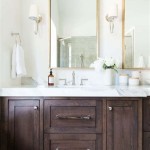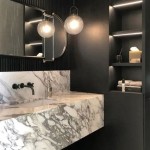Is Lino Good for Bathrooms?
Linoleum, often referred to simply as "lino," has been a popular flooring choice for many years due to its durability, affordability, and natural composition. While traditionally favored in kitchens and hallways, its potential for bathroom use has sparked debate among homeowners. This article delves into the advantages and disadvantages of using linoleum in bathrooms, providing a comprehensive analysis to help you make an informed decision.
Durability and Water Resistance
Linoleum's reputation for durability stems from its construction. It comprises natural ingredients like linseed oil, wood flour, and rosin, which are compressed and bound together. This natural composition makes it inherently resistant to water damage, making it a suitable choice for bathrooms. Unlike some other natural flooring options, linoleum does not readily absorb moisture, minimizing the risk of mold and mildew growth. However, it's essential to seal linoleum flooring with a high-quality water-resistant sealant to enhance its protection against moisture and spills.
Aesthetics and Customization
Linoleum offers a distinctive aesthetic appeal. Its warm, natural appearance can complement various bathroom styles, from traditional to contemporary. Moreover, linoleum is highly customizable, with a wide range of colors, patterns, and textures available. This versatility allows you to create a unique and personalized bathroom space. The ability to customize your linoleum flooring with bold colors, geometric patterns, or even artistic designs allows you to inject personality and style into your bathroom.
Maintenance and Cleaning
Linoleum is relatively easy to maintain and clean. Sweeping or vacuuming regularly removes debris and dust, while mopping with a mild cleaning solution keeps it looking its best. The smooth, non-porous surface of linoleum prevents dirt and grime from embedding, making it easier to clean than other porous flooring options. However, it's important to avoid using abrasive cleaners or harsh chemicals that can damage the surface and dull its appearance.
Limitations of Linoleum in Bathrooms
Despite its advantages, linoleum does have some limitations in bathroom settings. While it is water-resistant, prolonged exposure to excessive moisture can eventually lead to deterioration, especially if the sealant is not regularly maintained. Another consideration is that linoleum can be slippery when wet, posing a safety hazard. Installing non-slip mats or applying a non-slip finish can help mitigate this risk.
Alternatives to Linoleum in Bathrooms
If you're considering linoleum for your bathroom but have concerns, there are alternative flooring options. Tile flooring, particularly ceramic or porcelain tile, is an excellent choice for bathrooms due to its exceptional water resistance and durability. Tile also comes in a vast array of styles, colors, and textures, allowing for highly customized designs. Another popular alternative is vinyl flooring, which offers a durable and water-resistant surface at a relatively affordable price point.
Conclusion:
Linoleum can be a viable option for bathroom flooring, particularly for homeowners seeking a durable, natural and customizable flooring solution. However, its susceptibility to prolonged moisture exposure and potential slipperiness when wet necessitate careful consideration and proper maintenance. Ultimately, the best flooring choice for your bathroom depends on your specific needs, budget, and aesthetic preferences.

Best Natural Floors For Bathrooms Naturlich Flooring

Laminate Vs Linoleum Bathroom Flooring Which Is Better

Tile Vs Linoleum The Pros Cons Bath Granite Denver

Tile Vs Linoleum The Pros Cons Bath Granite Denver

How To Lay Vinyl Floor In A Bathroom Dove Cottage

Bathroom Vinyl Flooring What To Know Before You Buy

Diy Painted Linoleum Bathroom Floor House By Hoff

Loving Linoleum
Best Natural Floors For Bathrooms Naturlich Flooring

Bathroom Vinyl Flooring What To Know Before You Buy
Related Posts







